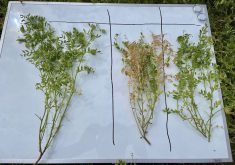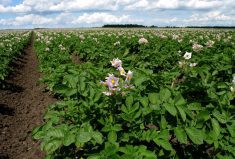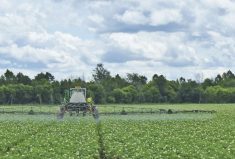We all look when we hear them. The sound of an airplane or helicopter sprayer is as distinctive as it is enticing. With an airplane, there’s that telltale roar of its high-powered engine and the pitch-shifting Doppler-effect. With a helicopter, there’s the unmistakable vibration stirring the air as it races from one end of a field to another.
Whether they’re applying a fungicide to a wheat field or corn crop, or whether they’re engaged in seeding a cover crop, aerial applicators are still a novelty on most farms, even as the circumstances necessitating their use are seemingly on the rise.
Read Also

Producers aren’t panicking over tariffs and trade threats
The influence of tariff and trade uncertainity on farm business decisions.
In spite of the glamour associated with flying, aerial applicators are facing the same cost-efficiency challenges that growers are contending with. Farmers may believe they’re in tough times these days, grappling with higher costs for seed, fertilizers, inputs, pesticide and fuel, but the pilots running these planes and ’copters are just as challenged in their operations.
As different as their machines are, aerial applicators are united in one other aspect: row-crop farming doesn’t make up a large portion of their annual income, despite the perception that more farmers are calling for their services. Still, it’s hard to discount the demand that does come from farming practices.
For most fliers, the bulk of their business comes from the forestry industry, with most of that taken up by seeding or reseeding operations throughout northern Ontario and even into Quebec and Western Canada. Agricultural applications may account for only 30 to 40 per cent, depending on the location of the service provider.
Paul Zimmer of Zimmer Air Services, near Blenheim, Ont., says it’s getting harder to justify some of the conditions that go with the farming portion of his business, something he doesn’t like to concede after 40 years of providing aerial application services.
“Right now, I would say that because of the fungicides that growers put on their corn and bean crops, we’re seeing a bit of resurgence in aerial applications,” says Zimmer. But that upsurge hides a difficult reality, he says. “We’re being regulated and really pushed out of business.”
The same crop-protection hoops and hurdles confounding farmers are taking their toll on Zimmer and many of his colleagues. The regulatory oversight imposed by the Ministry of the Environment and Climate Change (MOECC) is one of the biggest factors. Most products registered for in-crop use now require an aerial application permit process, and according to the MOECC Permit Application Guide for Aerial Application of Agricultural Pesticides, it can take up to 45 business days (nine weeks) to gain approval for a request for a permit.
“If that isn’t a way of saying, ‘You’re not going to do it,’ I don’t know what is,” says Zimmer. Even at two to three weeks, working as he does with an MOECC pesticide specialist who he knows, a farmer facing an outbreak of fusarium head blight can quickly run out of time. “If you have a crop dying from a fungus or it’s being drowned out by excessive rain, can you wait three weeks for a permit? And it’s no different than the neonic situation: this government is not agriculture friendly.”
It’s not even that it’s a national strategy, adds Zimmer, noting that there is no such permit approval process for Quebec, Manitoba, Saskatchewan or Alberta.
Same technologies, different realities
Zimmer uses many of the same technologies that farmers are using, such as GPS. There are also new advances in spray equipment such as flow control (if he slows his flight down a field, the flow adjusts accordingly) and automatic shut-offs for the end of a row.
But from an agricultural perspective, investing in those technologies is a tough call some years.
“There are advances going into our machines, but I’m never certain of how much I’m going to do since we’re basically the last resort,” says Zimmer, referring to both spray and seeding applications for farmers. “With seeding, that’s very hit and miss — we might not do that for two or three years. Yet having said that, over the past two to three years, there seems to be a resurgence and we seem to be getting a lot of calls about cover crops.”

Despite such an upturn in interest and the potential for more business in agriculture, Zimmer points out that most farmers who are calling about seeding cover crops often want it done sometime during the late summer, between mid-August and early September. But that’s the time of year when he has packed up his helicopters and headed north.
“So we’re struggling with whether we should keep a machine around to do that, but again, seeding isn’t a big money generator for us,” says Zimmer. “It’s a lot more work because you’re hauling heavy loads, plus you have to have guys on the ground to help the process.”
Best hope may be cover crops
In spite of the associated costs and the logistical headaches of answering the demands of growers for cover crops, Paul Hodgins believes that’s where there’s a greater potential. As president of General Airspray Ltd. of Lucan, Ont., he has also seen an increased demand for his services in air seeding cover crops.
Aerial applications for Hodgins generally took a hit with the recession in 2008. He notes that it often takes two years for the forestry industry to react to such an economic downturn, which is what happened this time too, with the crunch coming in 2010. About that same time, he started getting calls about spraying fungicides on corn as a growth regulator. His first was in 2007, and originally, the farmer didn’t like his asking price.
“Then BASF started calling, and said, ‘We still want you to put about a dozen plots in: we’ll pay you to spray it and the farmer will buy the chemical,” recalls Hodgins. “So we ended up doing 35 plots for them between Lucan and Exeter, and the next year, we did 12,000 acres.”
Then the use of fungicides in corn tailed off, at least where Hodgins was concerned, and he put it down to a drop in commodity prices. Yet in subsequent years he has seen the demand increase with higher grain prices.
“I have one big customer who says, ‘I will drive through my wheat, and I’ll drive through my beans, but I will NOT drive through my corn,’” says Hodgins.
Of late, Hodgins has been fielding more requests and doing more fact-finding about cover crops, much the same as Zimmer. For Hodgins, there’s been interest in ryegrass as a cover, as well as oilseed radish, and even some more elaborate blends which include crimson clover. Just as cropping plans and practices differ from farmer to farmer, so can the demand for a cover crop.
Like Zimmer, however, Hodgins recognizes that call for the air seeding of a winter cereal comes only as a last-minute decision by growers, often made in spite of any higher operating or seed costs. Some growers value maintaining their rotations, while others who are more concerned with growing conditions heading into winter may opt for another year of soybeans.
Size and distance
In that sense, Hodgins believes that farm size is playing a great role in calling in an aerial applicator. As the size of the operation grows, so does their skittishness. They’ve got more acres to cover, yet they often also are better at appreciating the financial penalty if they don’t get the job done.
Another factor that plays a significant part of the decision-making process — for the flying services — is tied to travel, and how far will they go to do business. Given the tighter margins and demand for keeping their costs manageable, both Zimmer and Hodgins opt to do business as close to home as they can. Although it’s true that Hodgins needs a runway from which to operate while Zimmer can put one of his Robinson R44s on a flatbed truck and haul to a job site, there is a limit to how far Zimmer will go.
“In agriculture, as long as I can make the numbers work, we’ll go,” says Zimmer, who went to New Liskeard and planted a few thousand acres of winter wheat last fall. “But when things are busy, I’m going to stick closer to Kitchener, west and maybe a little north. We don’t do too much the other side of Toronto, but if there’s a call for it and it can make economic sense, and we can put our helicopters on our trailers, then we’ll go. That’s why we truck these around: it’s hard enough to compete and these machines are so expensive on a per-hour basis, even compared to an airplane.”
From a logistics perspective, Hodgins only needs a runway close to a farmer’s field. There, the dealer or farmer can park a water truck and load it along with the fungicide, seed or the fertilizer.
So, which is better, a helicopter or a fixed-wing? Zimmer and Hodgins agree that each has its strengths: helicopters don’t require a runway but airplanes can perform slightly tighter turns to get coverage on unique angles in a field.
Both also provide good coverage, including below the canopy.
“We get good penetration from our AgCat,” says Hodgins. “A ground sprayer’s going at five miles an hour, whereas we’re getting 110, so we have the speed of the spray being driven into the canopy.”
















